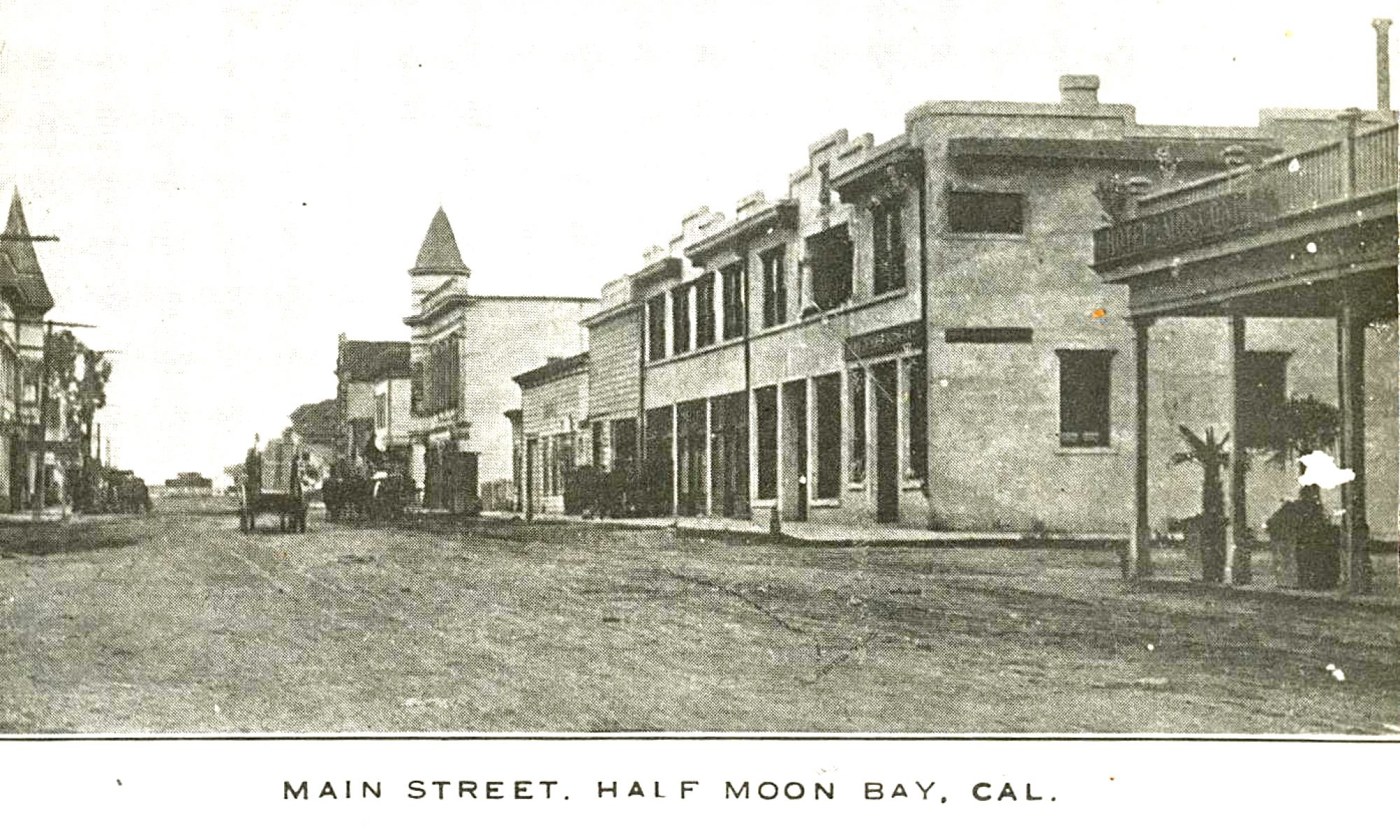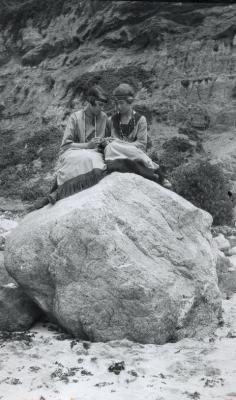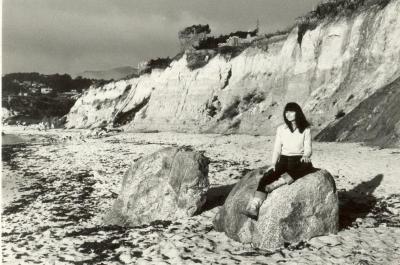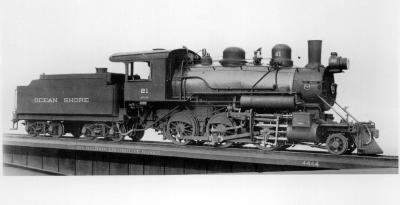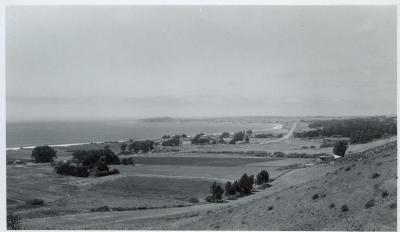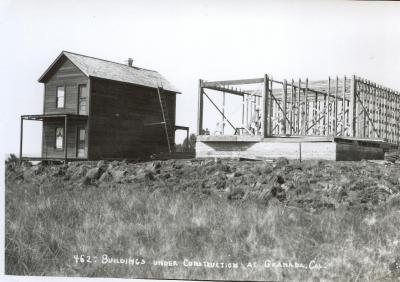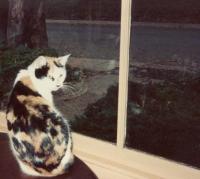Caught in the glimmer of his glamorous Half Moon Restaurant: Paul Shenkman of Cetrella.
At Moss Beach Old Rocks Don’t Crumble….
Murder in Montara: Babes in the Woods Case 1946: Part VI
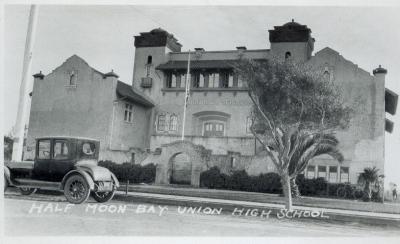 Photo, at right: The preliminary hearing for Vorhes Newton was held at the old Half Moon Bay High School.
Photo, at right: The preliminary hearing for Vorhes Newton was held at the old Half Moon Bay High School.
There was so much interest in the 1946 âBabes in the Woodsâ? case that the arraignment of the 24-year-old âconfessedâ? murderer Vorhes Newton had to be moved from Half Moon Bay Judge Bettencourtâs intimate courtroom to the much larger school gymnasium.
The schoolâs gym could accommodate the 65 officials, attorneys, family members, press and news photographers gathered for the brief proceedings. Children were kept out but you could see their curious little faces pressed against the windows of the building.
A dozen members of the defendantâs family sat behind Vorhes, whose hunched shoulders gave him a fragile bearing. The black eye he sustained in an accidental fall at Lake Tahoe, where he was apprehended, was now turning a sickly green and yellow.
When he turned to look at his mother, she pressed her sonâs hand meaningfully, her eyes brimming with tears.
Vorhes Newton was accused of brutally murdering his two daughters, more babies, than children. He was also accused of attempting to murder his wife, and the mother of his children.
To record the seriousness of the moment, photographers, six of them, moved adroitly about the room, the searing white light from their flash bulbs creating a photographic memory in the newspapers.
Vorhes Newtonâs brief appearance at the first legal proceeding consisted of a few questions and then it was over and sheriffâs deputies drove the defendant back to the county jail at Redwood City.
A few days later Newton attended a more significant legal event, the inquest into the death of his two small girls discovered in a remote part of Montara on the San Mateo County Coastside. Their traumatized mother, Lorraine, survived the vicious attack but was still recovering from serious injuries in a Half Moon Bay hospital.
Sheriffâs deputies escorted their prisoner, attired in tan slacks and a jacket, his black eye completely healed, from the jail to a nearby mortuary chapel where a jury convened to hear testimonyâwhich turned out to be more grisly details of the killings.
Witness Jimmie Fideler, a Montara rancher, testified that he saw Vorhesâs wife. âShe had a black eye and was staggering. She had blood over her blouse,â? Fideler said, âand appeared to have been badly beaten. She told me she had been wandering all night on the road.â?
Fideler said that well known Coastsider John Kyne was with him. Kyne told the jury, âAll of us knew about the car going up the road the afternoon before, with a woman screaming, so we were on the alert that morning.â?
Kyne was talking about the car driven by Vorhes Newton, with his wife and children as passengers.
Upon advice of counsel, Newton himself refused to testify. The support he had from his family was evident again: when he returned to the jail he was accompanied by his sister and her husband, the same sister he had borrowed the car from for the tragic ride from the East Bay to the Coastside.
Following the testimony, the coronerâs jury– three men and three women, described as housewives–found that Barbara Ann Newton, 23 months old and Caroline Lee Newton, seven months, âcame to their death from skull fractures caused by blows with a blunt instrument wielded by person or persons unknown.â? They recommended further investigation by the district attorney.
Lorraine Newton was recovering from a skull fracture at Community Hospital in Half Moon Bay and did not attend any of the early proceedings. It was said that she didnât know what had happened to her children. Her parents, the Frank Tuttles of North Hollywood, wanted to be the ones to break the horrific news to their daughter.
But Dr. Raycroft, the head of the hospital, convinced them it was his role to his patient âat the proper timeâ?. That meant without the authorities presentâand he would not allow Lorraine to see her husband.
Two weeks after her children had been murdered, and during the preliminary hearing in Half Moon Bay, Lorraine Newton, still hospitalized, spoke publicly, âtestifiyingâ? for the first time. Besides her parents, County Investigator Frank Marlowe, Deputy Sheriff Jack OâBrien stood at her bedside as Stenographer Virginia Knight recorded the emotionally charged evidence.
It was almost unbearable to hear Lorraine speak, her voice breaking frequently, moving forward through heavy sobbing only haltingly.
She said she woke up battered and bleedingwith daughter Barbara dead in her arms. While stumbling she fell into a creek, and wet and shivering, she found an abandoned chicken shed before losing consciousness.
Then Lorraine Newton cried so hard that the testimony had to be stopped so she could regain her âcomposureâ?..
She denied seeking an abortion but said she intended to visit a doctor in San Francisco. What the purpose of that medical visit was we donât know. Again she recalled part of the fatal automobile ride, watching the waves at Rockaway Beach in Pacifica– and then remembering nothing until she woke up with her dead child in her arms.
Lorraine recalled that she and Vorhes didnât argue but that he was moody at Rockaway Beach. âWhen I last saw him,â? she said, â he was sitting in the car. Then I remember nothing until I woke up lying over my babyâs body.â?
Meanwhile, at the preliminary hearing held at Half Moon Bay High School, Assistant District Attorney Fred Wycoff questioned a dozen witnesses, establishing the facts of death, the murder ride, the discovery of Mrs. Newton and the children, the capture of Vorhes at Lake Tahoe and the finding of his wifeâs rings in his pockets.
Wycoff produced a witness, a Mexican farm worker, who testified seeing the man who drive into the canyon at Montara with a woman, and later emerge without her.
âInsufficient evidence,â? countered the famous defense attorney Leo Friedman, moving for dismissal.
There was the obligatory moment of silence– and then Judge Manuel Bettencourt ruled that Vorhes Newton be bound over for trial.
Outside the courtroom, Newtonâs attorney Leo Friedman courted reporters, verifying that Newtonâs neighbors said Lorraine was the quarrelsome half of the couple. He said that John Kyne discovered Lorraineâs rings were gone. When found, she was wearing a glove and Kyne helped her remove it to reveal the missing rings.
Could that mean Vorhes Newton ripped the glove off his wifeâs hand and took the rings, âDid he put her gloves back on her?â? Friedman asked reporters.
Six months passed before the trial would begin.
…To be continued…
Ocean Shore Railroad Model
The Hwy 1 Era
Three decades after the Ocean Shore Railroad declared bankruptcy and pulled out of the Coastside, the train’s right-of-way was paved over with a new road, eventually called Hwy 1. The paving occured in stages up and down the Coastisde, between the 1940s and 50s.
This R. Guy Smith photo could have been taken in the early 1950s–when development was taking place on “the other side of the hill” but not on the Coastside, still wide open. In this picture it seems the Ocean Shore left us little to remember it with. But if you look closely some landmarks are visible such as the old Amesport Pier (1860s, rebuilt 1916) at Miramar. That’s Pillar Point to the north.
Notice there’s no traffic? What’d they do, close the highway so the photographer, R. Guy Smith, could get the shot? Nice.
El Granada Vignette
(At below,right) About 1908, the Ocean Shore Railroad (smoky, isn’t it?) delivers and picks up well-dressed pasengers at an El Granada train station. 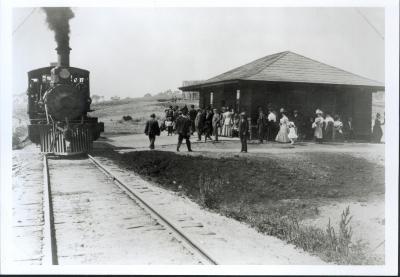
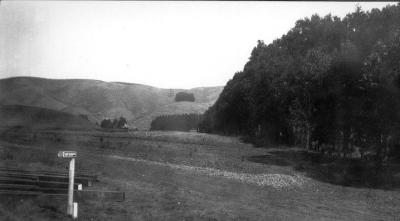 (At below, left) The Ocean Shore ignites a “land boom” in El Granada, and, where once artichokes grew, street signs appear–but no sidewalks or houses–yet.
(At below, left) The Ocean Shore ignites a “land boom” in El Granada, and, where once artichokes grew, street signs appear–but no sidewalks or houses–yet.
While waiting for houses, summer and all-year-round to be built, new lot owners camped out in tents like the one below at El Granada: 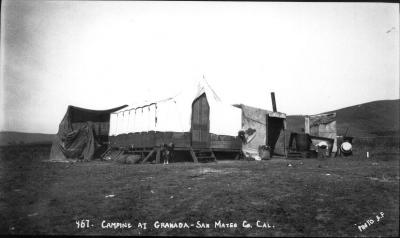
Bubba, the Swimming Cat, Visits Half Moon Bay
Bubba, the Swimming Cat Visits HMB
Yesterday, when I walked out of the pharmacy in HMB, I saw a cat on a leashâgently tied to somebodyâs green backpack resting on the ground.
Iâm a cat lover, the owner of two bobtails, so my heart went straight to this multi- gray striped cat with a tailânot just because it was on a leash, which is unusual enough to make anyone look twice.
But this cat was calm and unafraid– even though I thought it was clearly vulnerable.
Its fur was shiny, slick and clean. And its clear knowing eyes told me, lady, Iâm no ordinary cat.
This was a worldly cat, an experienced cat– a wise and patient cat.
All this flashed through my mind when the catâs owner walked out of the store.
He looked a little travel-worn but he didnât notice me. To the cat he said, âIs everything all right?â?
I guess everything âwas all rightâ? because he sat on the cold concrete next to the cat, resting, looking at nothing in particular. I noticed he had a jagged cut above his right eye but I decided not to ask about the wound.
Instead I asked about the cat.
âIsnât your cat afraid of dogs?â?
âHe IS a dog,â? he answered. âHe grew up around dogs. He knows how to handle them. He can protect himself.â?
Then he told me the most remarkable thing: âThis cat can swim. We were in Santa Cruz over the weekend, â and the rest trailed off.
âReally?â? I marveled, imagining a swimming cat. One of my cats, the girl, tentatively tests the drinking water in her green bowl with one paw, but I couldnât envision her stepping into any body of water.
Hoping for more stories about this intrepid animal, I said, âYou take great care of him.â? I thought he must brush him all the time but he informed me, âHe grooms himself. He licks himself every two minutes. I take good care of my cat.â?
Our conversation was coming to an end but I wanted to know one more thing. âWhatâs his name?â?
âBubba. We were supposed to go to Alaska, âhe added almost absentmindedly. â⦠catch a flight out of Oregon.â?
These two, Bubba and his owner, were one, inseparable, and I left them that way in Half Moon Bay, wondering how these traveling companions would deal with the harsh Alaskan weather in the dead of winter.
But if the cat can swim, Iâm sure they can survive anything.
Muslims Celebrate Holy Day on the Coastside
Three Richards….
But I have a photo of only one.
When I first came to the Coastside in the 1970s I was not only very young but there were other very young people living here, too. Not many–because the population, in general, was a low number. They had come from Buffalo, NY, Ohio and southern California– I don’t think I met anyone who had grown up in San Francisco, like me.
I have struggled, and continue to struggle with trying to explain why they were here, the attraction. It was unusual, I thought. The common denominator seemed to have something to do with strong personalities and a need for independence. Because the Coastside was a big, open place in the 1970s there was lots of space around these people and you could see them clearly. No blurring. They had definition.
The real locals, the authentic ones who had lived here all their lives, could have described us as “the intruders”, but it’s my word. We intruded on what had been exclusively theirs for decades.
To the Richards: There was “Rotten Richard”. He was thin and wiry and worked as an electrician. Everybody called him “Rotten Richard” but I don’t know why. He was a nice guy. He lived in a big, new house at the golf course when the golf course was very young. I (and my ex) were invited to a party there and Rotten Richard played host to his many friends– and I recall feeling surprised when the lady mayor, better known as “The Godmother”, strolled through.
Another Richard was Richard English– who had to be distinguished from the third Richard, Richard “the Englishman” who is an Englishman.
Unlike the other two Richards who had nicknames, Richard English didnt’ have one. Maybe that’s why he called himself “Big Red Dick” He was a tall, trim, redheaded man,, the kind of guy you were always glad to see. You knew he could make you laugh, a funny thing he personalized just for you.
This Richard also kept busy in the building business–but in the 1970s “wanderlust” had a grip on him. He was always moving away from the Coastside. And every time he announced he was leaving, someone would throw a wild party for him. The last one I recall was given by the beautiful Leah, the manager of the popular Crab Cottage in Princeton owned by El Granada’s Tom Monaghan. The doors of the restaurant, now gone, closed, and great fun was had by one and all.
 PHOTO at left: The Crab Cottage, in Princeton, a seafood restaurant, now gone, where goodbye parties were held for the, red-haired Richard English. You can see the Princeton Hotel across the way from the Crab Cottage.
PHOTO at left: The Crab Cottage, in Princeton, a seafood restaurant, now gone, where goodbye parties were held for the, red-haired Richard English. You can see the Princeton Hotel across the way from the Crab Cottage.
But Richard English couldn’t stay away from the Coastside for long–everytime he left he soon returned and spent the rest of his life here.
Of the three Richards, I only have a picture of the successful Coastside plumber, Richard Henry, also known as “Richard the Englishman”–because he has an English accent. When there were no fences to stop you from riding your horse from Montara to Half Moon Bay, Richard, his dark curly hair flying in the wind, zipped along the cliffs. Within recent years, he came to a party at my house in El Granada– riding in a horse-driven cart all the way from Montara–down Hwy 1.
BELOW: Here’s a photo of Richard “the Englishman” taken 30 years ago.
Sadly, two of the Richards are gone. “Rotten Richard” died long ago and recently we lost Richard English, a resident of Pescadero. BUT I DO NOT WANT TO CONFUSE YOU–RICHARD HENRY, “the Englishman” and Coastside plumber, is still around and graces us with his charming English accent.
